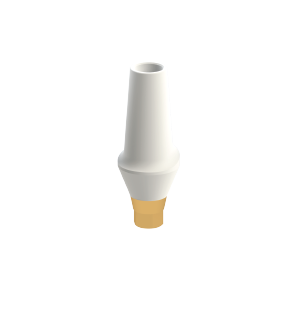Zircocam™: Premium Zirconia Abutments in Dubai | Edison Medical UAE
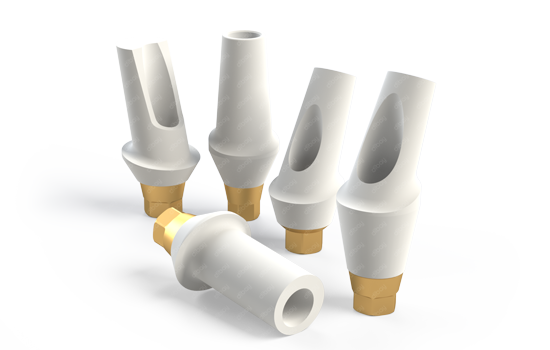

Zirconia Abutment in Dubai by Edison Medical UAE
Zircocam™: Zirconia Abutment with Titanium Base
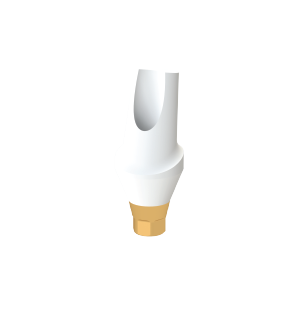
Zirconia proves to be an optimal choice for implant abutments in situations where concerns about aesthetics and metal allergies arise. The Zircocam™ zirconia implant abutments from Edison Medical are fortified with a titanium base, and a titanium fixation screw accompanies each abutment.
Edison Medical's Zirconia Abutment and Compatibility with Implant Brands
Zircocam™ abutments are offered in regular and narrow platforms, with three angulations available: straight, 15°, or 25°. Each angulation is provided in three distinct collar heights and total lengths. EM’s Zircocam™ abutments are compatible with over 90 dental implant systems, including Astra Tech®, Straumann®, Zimmer®, Nobel Active®, Osstem® / Hiossen®, and MegaGen®.
Improving Aesthetics with Zirconia Abutments
Zirconium dioxide is ideal for the aesthetic aspect of dental implants. One of its key advantages, shared with zirconia crowns, is the translucent, white color that closely resembles natural teeth. This quality makes zirconia implants less conspicuous, especially for patients with thin tissue where the implants may be visible at the gumline. Moreover, similar to titanium and metal implants, zirconia is radiopaque, ensuring visibility on X-rays and scans.
Strength and Reliability: Zirconia abutments vs Titanium abutments

Zirconium dioxide abutments, which have a monoclinic crystalline structure at room temperature that transitions to tetragonal and cubic crystalline structures with increasing temperature, stand out as the most robust among ceramic abutments. Essential attributes for a high-quality implant abutment are superior strength, biocompatibility, and naturally appealing esthetics.
To achieve high strength, biocompatibility, and natural-looking esthetics, various metal oxides are added to the raw zirconia (ZrSiO₄), including yttrium oxide (Y2O₃), magnesium oxide (MgO), cerium(III) oxide (Ce₂O₃), and calcium oxide (CaO).
This addition serves to stabilize the tetragonal crystalline phase of the zirconium, prevent corrosion by water, and diminish pore development and coloration components. The resultant zirconia exhibits clinical performance equal to titanium in terms of esthetic, technical, and biological outcomes.
Metal-Free Zirconia Abutment

Abutments made of zirconium dioxide do not contain any metallic components. They serve as a substitute for metal alternatives, catering specifically to patients who experience allergies or sensitivities to metal materials. Moreover, zirconia abutments can withstand the potentially damaging effects of acids commonly found in the oral cavity, contributing to their longevity and suitability for patients with specific sensitivities.
From a microbiological point of view, zirconia has low bacterial adhesion, minimizing the risk of periodontal problems around the restoration.
When to Use Zirconia Implant Abutments?
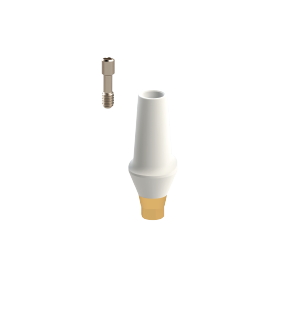
Zirconia is more successful in areas of the lower force and areas of esthetics, such as anterior teeth restoration. Dental professionals recommend zirconia implant abutment when patients have thin gingival tissue or a thin periodontal biotype. Zirconia abutments address the grey hue forming around the implant area, offering a more aesthetically pleasing option. These abutments also have clinical advantages, including excellent mechanical strength, reliability, and biocompatibility.
Zirconia Implant Abutments VS Titanium Implant Abutments
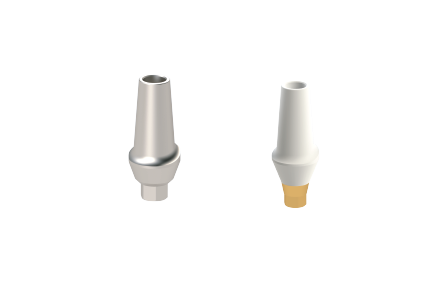
Dental professionals often turn to implants when a tooth is indicated for extraction or when there are one or more missing teeth. The more permanent process involves surgically affixing a "metal implant abutment" to the jawbone, onto which new crowns are then attached.
Titanium has been the predominant material for over 50 years due to its reliability, durability, and widespread use, especially for patients with tooth loss due to accidents, tooth decay, infection, or periodontal disease. Titanium abutments are known for their durability and versatility, making them the industry standard.
Advantages of Zirconia Abutments
Advances in CAD/CAM Dentistry and the popularity of zirconia as a crown material have introduced zirconia as an alternative to "titanium and zirconia abutments." Let's compare the two.
Biocompatibility and Osseointegration of Zirconia Abutment
Zirconia resist bacterial formation, which contributes to better long-term oral health, and has demonstrated strong potential for osseointegration, which contributes to the long-term success of the implant.
Strength of Zirconia Abutment
Zirconia is one of the strongest technical ceramics and is particularly suitable for the posterior teeth where the grinding and biting forces are more powerful.
Aesthetics of Zirconia Abutment
The translucent, white color of zirconia mimics natural teeth, making the implants less noticeable, especially in the smile zone.
Strength Compared to Metal Implant Abutments
While zirconia is strong, it is not as durable as titanium, which may be a consideration for those looking for a particularly robust abutment.
Advantages of Titanium Abutments
The choice between zirconia and titanium abutments depends on factors such as strength requirements, aesthetics, cost considerations, and the patient's specific needs.
Biocompatibility & Osseointegration of Titanium Abutment
Titanium is biocompatible and has excellent osseointegration, making it well-tolerated by most patients.
Strength of Titanium Abutment
Titanium abutments are known for their toughness, fracture resistance, and impressive flexural strength.
The Durability of Titanium Abutment
Patients have reported long-term success, with corrosion resistance and durability over their lifetimes.
Aesthetically Pleasing One-Piece Custom Zirconia Abutment
The custom zirconia abutment is widely used for esthetic implant abutments. This versatile esthetic abutment can be fabricated by scanning a wax-up followed by milling or entirely through CAD/CAM. Compared to other esthetic custom abutment options that allow an all-ceramic restoration, the zirconia abutment is characterized by its efficient design.
Efficient Design and Fabrication of Zirconia Abutments
.png)
The primary concerns frequently addressed are "strength" and "fracture." Although zirconia is an excellent alternative to metal, its strength, particularly in thin areas, does not match metal's. If the abutment design results in overly thin axial walls due to implant positioning, there may be more suitable abutment material than zirconia.
Fractured Zirconia Implant Abutments

One concern with "one-piece" zirconia abutments is wear at the titanium–zirconia interface. Interestingly, higher wear is generally observed at the implant interface with a one-piece zirconia abutment than titanium abutment.
For a high success rate with zirconia implant abutments, they should be strategically placed in areas exposed to lower masticatory forces and preferentially with a secondary metal component for the internal connection into the implant.

